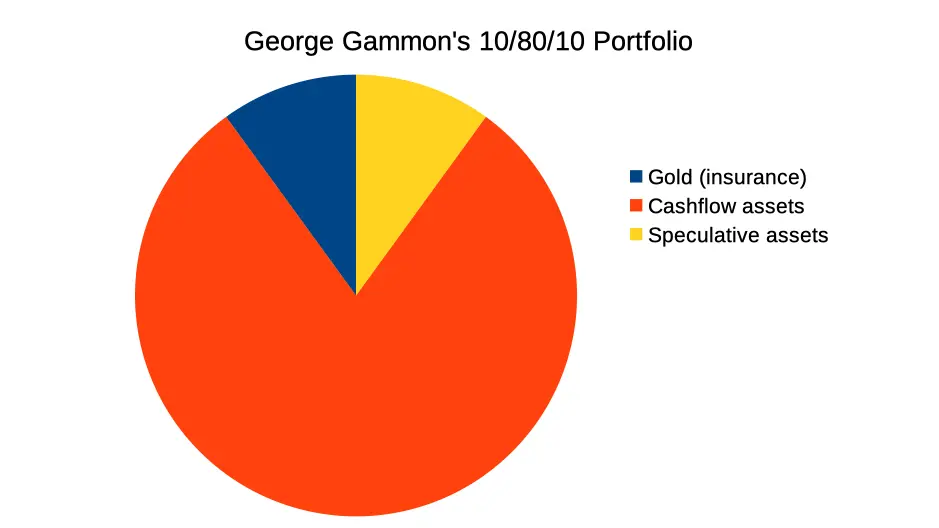DISCLAIMER: Below is an article with ideas or a personal stance about finances. This article is not financial advice. Investing is risky. Please consult with a financial advisor before investing.
The economy is caught in a push-pull between inflation and deflation, interest rates or no longer at historic lows and might be trending up for a while and on top of that, bonds no longer appear to be the hedge they once were.
The big question is how do we create a portfolio to weather the storm in these conditions? Many great investors are moving away from traditional investing advice and coming up with their own version of an all-weather portfolio.
Today, we’ll take a look into George Gammon’s 10-80-10 portfolio.
[humix url=”https://www.bizfinlife.com/humix/video/e9f6452c1f48f410006ac14452fbc09492259a5029bbf8cd42e394db064afba1″ float=”1″ autoplay=”1″ loop=”1″]
10-80-10 Portfolio
We’ve already mentioned George Gammon’s 10-80-10 portfolio in our post about portfolio management for online lifestyle entrepreneurs, but in this article, we’ll look further into this particular portfolio and how we might create a 10-80-10 portfolio for ourselves.
On the surface, the 10-80-10 portfolio looks simple and flexible.

Gold (insurance)
George Gammon recommends holding about 10% gold at all times as insurance.
You could look at gold as being the safe bond alternative in his opinion.
While gold might sell off (at first) during liquidity problems (like traders getting margin calls), it eventually recovers and outperforms equities during hard times (like during the short covid crash).
Gold has also proven to be a great hedge against inflation over longer time frames.
Gammon, therefore, regards it as the small insurance part of his 10-80-10 portfolio.
Cashflow Assets
The lion’s share of the 10-80-10 portfolio is the cashflow assets part, which accounts for 80% of the portfolio size.
This chunk is quite flexible, only requiring assets to generate cash flow, so it could contain dividend stocks, real estate, business, etc.
George Gammon likes to “buy a dollar for 50 cents instead of buying a dollar for 2 hoping to sell at 5“. In other words, he’s a value investor hoping to pick up great assets when they’re underappreciated and underperforming instead of chasing the next FOMO trade to the moon.
He is on the same wavelength as people like Robert Kiyosaki or Grant Cardone (or this website), in believing the goal of investing should be to replace your active income with passive income as soon as possible, more than collecting paper gains and redeeming them (and get taxed massively) at retirement.
Gammon’s definition of investing is “buying assets that generate cash flow“, contrary to speculating which Gammon describes as “buying assets with the sole intention to sell them at a higher price“.
Speculative Assets
This takes us to the final part of the 10-80-10 portfolio, speculative assets.
As mentioned earlier, George Gammon is no fan of chasing moon shots for paper gains. That doesn’t mean he doesn’t believe there’s a time and place for making a small speculative play, he just never allocates more than 10% of his portfolio to them.
There are always ridiculously undervalued assets that might 5x or even 10x their value in relative short time. Good investors know to take advantage of such opportunities by making short-term plays and increasing the size of their portfolios.
One example of a speculative play Gammon likes to bring up is Bitcoin or crypto in general (no, he doesn’t believe in the digital gold narrative). It’s definitely one of the more risky plays out there, but the potential is (still) huge.
So if such an opportunity arises, feel free to make use of them. Just don’t overdo it, because if the market turns against you, you might blow up your portfolio. No crazy moon shots! Just well calculated, limited risks.
Conclusion
So this is the 10-80-10 portfolio as introduced by George Gammon. It’s definitely more on the conservative side, although it does allow for a lot of flexibility in the 80% cash flow part, there are some more risky cash flow plays one might consider out there. But we definitely do agree that cash flow should be the number one focus of any portfolio in the wild, with the goal to replace your active income with passive income.
What do you think about the 10-80-10 portfolio? Is it something you would consider? Maybe it’s too conservative for you, perhaps in that case you’d like the 10-triple-30 portfolio, which is loosely based on this one and specifically engineered for online lifestyle entrepreneurs.
Anyway, let us know what’s your opinion about this portfolio.
